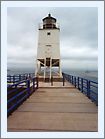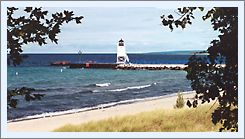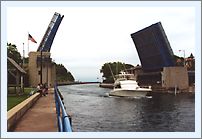|
Historical Information

By the mid 1800's, lumber was king in Michigan, and the
Charlevoix area was graced with a seemingly endless supply of tall pine
forests surrounding Round and Charlevoix lakes.
The villagers of Charlevoix knew all too well that opening-up the
shallow Pine River to navigation between Lake Michigan and Round Lake
would create one of the most protected harbors on the Great Lakes.
Further, they realized that such a move would not only facilitate the
shipment of lumber, but would also contribute significantly the
long-term economic viability of their village.
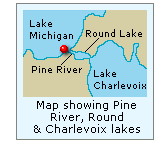 Unfortunately the
cost and scope of such an undertaking was prohibitive. As a stopgap
measure a 900 foot-long dock was built from the shore of Lake Michigan
in the 1860's. Located some distance north of mouth of the Pine River,
the wooden dock was wide enough to allow horses and wagons to bring
loads of lumber out to the waiting vessels tied to its sides. The dock
was soon busy throughout the shipping season. However, exposed as it was
to wave, rot and crushing winter ice, it was quickly plain that such an
exposed dock was not a viable long-term solution. Unfortunately the
cost and scope of such an undertaking was prohibitive. As a stopgap
measure a 900 foot-long dock was built from the shore of Lake Michigan
in the 1860's. Located some distance north of mouth of the Pine River,
the wooden dock was wide enough to allow horses and wagons to bring
loads of lumber out to the waiting vessels tied to its sides. The dock
was soon busy throughout the shipping season. However, exposed as it was
to wave, rot and crushing winter ice, it was quickly plain that such an
exposed dock was not a viable long-term solution.
In 1873, the opening-up of the Pine River was finally undertaken.
Slowly and laboriously, the river was cut and dredged by hand until it
was thirty-five feet in width, and twelve feet in depth. It became
evident that wave action along the Lake Michigan shoreline at the newly
enlarged river mouth would quickly silt-up the waterway with sand,
undoing the work that had been undertaken. In order to help prevent such
action, the decision was made to build a pier immediately north of the
Pine River to break the wave action, and protect the river mouth.
That winter, nine sixteen foot by forty-foot wooden cribs were
constructed on the ice. The two-foot thickness of ice was cut through,
and the cribs allowed to sink to the bottom. The cribs were then filled
with rock to strengthen the assembly, and to add mass. While spring
storms damaged some of the structure, by the summer of 1874 the
structure was repaired and stabilized.
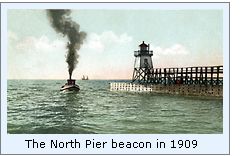 In 1884, the Lighthouse Board decided to erect a light on the outer
end of the north pier to serve as a guide to increasing maritime traffic
taking advantage of the improved channel. Eleventh District Engineer
Captain Charles E. L. B. Davis drew on a common pierhead beacon design
for the new Light, pre-building the structure at the Detroit Depot, and
then delivering the components to Charlevoix on board the tender WARRINGTON. Taking the form of a white painted simple timber-framed
pyramid structure standing 30 feet in height, the upper section was
enclosed to serve as both a service room and as shelter for the keeper
during inclement weather. Above this service room, an octagonal cast
iron lantern was centered on a square gallery with iron handrails, and
outfitted with a fixed red Fifth Order Fresnel
lens. With construction
of an elevated timber walkway from the shore to the beacon, construction
was completed. Wright Ripley, who had served as First Assistant at Port
Austin Reef Light for the past two years was promoted to the position of
Acting Keeper of the Charlevoix Light. Arriving at the station, Ripley
made his way along the pier to exhibit the new light for the first time
on the night of September 1, 1885. Standing atop the pier seven feet
above the lake surface, the lens sat at a focal plane of 37 feet, and
was visible for a distance of 9 ½ miles at sea in clear conditions. In 1884, the Lighthouse Board decided to erect a light on the outer
end of the north pier to serve as a guide to increasing maritime traffic
taking advantage of the improved channel. Eleventh District Engineer
Captain Charles E. L. B. Davis drew on a common pierhead beacon design
for the new Light, pre-building the structure at the Detroit Depot, and
then delivering the components to Charlevoix on board the tender WARRINGTON. Taking the form of a white painted simple timber-framed
pyramid structure standing 30 feet in height, the upper section was
enclosed to serve as both a service room and as shelter for the keeper
during inclement weather. Above this service room, an octagonal cast
iron lantern was centered on a square gallery with iron handrails, and
outfitted with a fixed red Fifth Order Fresnel
lens. With construction
of an elevated timber walkway from the shore to the beacon, construction
was completed. Wright Ripley, who had served as First Assistant at Port
Austin Reef Light for the past two years was promoted to the position of
Acting Keeper of the Charlevoix Light. Arriving at the station, Ripley
made his way along the pier to exhibit the new light for the first time
on the night of September 1, 1885. Standing atop the pier seven feet
above the lake surface, the lens sat at a focal plane of 37 feet, and
was visible for a distance of 9 ½ miles at sea in clear conditions.
With no place to store the oil used to fire the lamp, a crew arrived
at the station in 1890 and erected an 8-foot by ten foot wood framed oil
storage building at the inner end of the elevated walk. During one of
that year’s visits by Ninth District Inspector Commander Charles E.
Clark, Keeper Ripley informed Clark that many larger vessels were
finding the water depth in the river to bee too shallow to accommodate
them, and these vessels had begun tying-up and unloading directly on the
north pier. Ripley complained that wagons being driven along the pier to
these vessels at night were creating a strong vibration, causing his
light to flicker wildly and the lamp to smoke excessively. It would
appear likely that the river was subsequently dredged, as Ripley never
raised the issue during subsequent inspections.
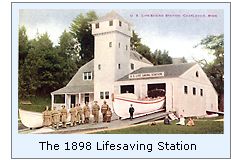 With increasing expansion of the lifesaving service throughout the
lakes, work began on construction of a new lifesaving station on the
north shore of the river entrance in 1898. Work on the new structure
continued over the following year, with the station officially placed
into service on July 5, 1900. As a result of deterioration of the timber
pier, the Army Corps of Engineers arrived in Charlevoix in 1904 to
completely rebuild the superstructure of the North Pier. During this
work, the beacon was elevated on blocking to allow work to continue on
the pier beneath. On completion of the work, the beacon was lowered back
to the pier level, anchored firmly to the new crossties, and the decking
reinstalled around it. n 1900 was also the year in which the Lighthouse
Board recognized the value of the protected harbor within Round Lake,
and built one of its five Great Lakes Depots at the junction of the
channel and the lake. With increasing expansion of the lifesaving service throughout the
lakes, work began on construction of a new lifesaving station on the
north shore of the river entrance in 1898. Work on the new structure
continued over the following year, with the station officially placed
into service on July 5, 1900. As a result of deterioration of the timber
pier, the Army Corps of Engineers arrived in Charlevoix in 1904 to
completely rebuild the superstructure of the North Pier. During this
work, the beacon was elevated on blocking to allow work to continue on
the pier beneath. On completion of the work, the beacon was lowered back
to the pier level, anchored firmly to the new crossties, and the decking
reinstalled around it. n 1900 was also the year in which the Lighthouse
Board recognized the value of the protected harbor within Round Lake,
and built one of its five Great Lakes Depots at the junction of the
channel and the lake.
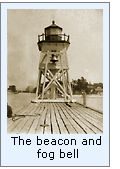 In order to serve during thick weather, a fog bell was installed on a
timber frame on the lakeward side of the beacon in 1909. The bell was
operated by an electrically operated mechanism located within the
service room, its striking arm passing through a hole in the service
room wall. Also in this year, the materials for a brick oil storage
building were delivered at the station, and the structure erected on
shore the following year. In order to serve during thick weather, a fog bell was installed on a
timber frame on the lakeward side of the beacon in 1909. The bell was
operated by an electrically operated mechanism located within the
service room, its striking arm passing through a hole in the service
room wall. Also in this year, the materials for a brick oil storage
building were delivered at the station, and the structure erected on
shore the following year.
With the Army Corps of Engineers undertaking further extension and
improvements to both the north and south piers in 1914, a number of
changes were undertaken to improve the lighting of the river entrance.
The old timber beacon was carefully lifted from the north pier and
carried across the river mouth and reinstalled on the end of the newly
extended South Pier. After the re-erection was complete, the beacon was
given a coat of bright red paint in order to help it serve as a more
effective day mark.
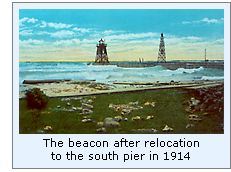 To light the newly extended North Pier, a 56-foot
tall red-painted steel tower was erected at the pier’s outer end.
Outfitted with an occulting white light, the light exhibited
characteristic alternating 3-second periods of light and dark, and was
visible for a distance of 12 miles. With this change, the station was
renamed ‘Charlevoix South Pierhead Light Station, and with two lights
to keep on opposite sides of the harbor entry, Keeper Ripley found his
workload more than doubled when he exhibited both lights for the first
time on the night of April 14, 1914.
To light the newly extended North Pier, a 56-foot
tall red-painted steel tower was erected at the pier’s outer end.
Outfitted with an occulting white light, the light exhibited
characteristic alternating 3-second periods of light and dark, and was
visible for a distance of 12 miles. With this change, the station was
renamed ‘Charlevoix South Pierhead Light Station, and with two lights
to keep on opposite sides of the harbor entry, Keeper Ripley found his
workload more than doubled when he exhibited both lights for the first
time on the night of April 14, 1914.
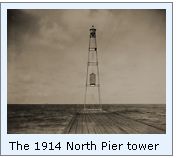 Despite the additional workload, Ripley was evidently well suited to
life at Charlevoix as he continued to serve as the single Charlevoix
Keeper until November 15, 1923, when he retired after holding office at
the station for a remarkable thirty-eight years. Captain William H
Shields, who had lost his leg during a tragic boating accident at Squaw
Island light station in 1900, had since been serving "light duty" at the
Charlevoix lighthouse depot, and longing to return to lighthouse service
was selected to replace Ripley. Despite the additional workload, Ripley was evidently well suited to
life at Charlevoix as he continued to serve as the single Charlevoix
Keeper until November 15, 1923, when he retired after holding office at
the station for a remarkable thirty-eight years. Captain William H
Shields, who had lost his leg during a tragic boating accident at Squaw
Island light station in 1900, had since been serving "light duty" at the
Charlevoix lighthouse depot, and longing to return to lighthouse service
was selected to replace Ripley.
As part of a system-wide upgrading, the fog bell on the South Pier
Light was removed in 1938, and replaced by an electric
compressor-powered Type C diaphone, sounding groups of two blasts
followed by 20 seconds of silence. With electricity available on the
pier, at the same time the kerosene lamp in the beacon was replaced by
an incandescent electric light bulb, increasing the output of the light
to 1,500 candlepower.
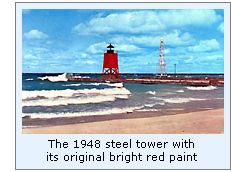 After 63 years of constant exposure to the elements, and showing
signs of terminal deterioration, in 1947 the decision was made to
replace the venerable timber tower with a more durable steel beacon. The
new structure was manufactured in Milwaukee, and shipped to Charlevoix
in 1948. After the old Fifth Order Fresnel lens and lantern were
carefully removed, the old beacon was destroyed, and the new steel tower
swing into its place at the end of the South Pier. The lantern and lens
were reinstalled in the new tower, and the structure was given a fresh
coat of bright red paint. After 63 years of constant exposure to the elements, and showing
signs of terminal deterioration, in 1947 the decision was made to
replace the venerable timber tower with a more durable steel beacon. The
new structure was manufactured in Milwaukee, and shipped to Charlevoix
in 1948. After the old Fifth Order Fresnel lens and lantern were
carefully removed, the old beacon was destroyed, and the new steel tower
swing into its place at the end of the South Pier. The lantern and lens
were reinstalled in the new tower, and the structure was given a fresh
coat of bright red paint.
With space on the Pine River channel at a premium, the Coast Guard
vacated the old Life Saving Station in 1965, and relocated to the
grounds of the old Lighthouse Supply Station. Sadly, the historic
shingled building was demolished soon thereafter.
The old wooden pier with its concrete covering was replaced in 1989
with the present steel and concrete structure. The construction of the
existing piers and revetments was accomplished in the 1970's and 80's.
Constructed of driven steel piles with concrete and rock fill, wooden
buffers were added where needed. These new piers were designed to
incorporate hydrodynamic features to protect the harbor area. The
rectangular gaps beyond the beach are intended to absorb and break-up
inbound wave force, thereby reducing the swells that would travel from
the big lake all the way up the channel into Round Lake.
The Pine River Channel is believed to be unique in the entire world
inasmuch as it has a two-way current. After severe westerly windstorms,
waters pushed high into Lake Charlevoix will swiftly flow back out to
meet other inbound currents. Small whirlpools and eddies at the harbor
mouth are not uncommon, and whitecaps can frequently be observed within
the channel on the calmest days.
The Coast Guard still maintains an active presence in Charlevoix to
this day, and actively patrols a 2,500 square mile area of Lake Michigan
with its four vessels. While the steel beacon was painted white during
the early 1980’s, and the Fresnel lens replaced by a 300 mm acrylic
optic, the Charlevoix South Pierhead Light still serves as a guide to
the myriad pleasure craft which enter and leave the busy river during
the summer season.

Keepers of this Light

Click Here to see a complete listing of
all Charlevoix Light keepers compiled by Phyllis L. Tag of Great Lakes
Lighthouse Research.

Seeing this Light

Charlevoix was our first stop after leaving the warmth of the cottage.
The light is an unimposing skeletal structure sitting on the pier
protecting the passageway into Lake Charlevoix.
The City of Charlevoix is a tourist Mecca, and many vacationing boats
seek the safety of the protected harbor within Lake Charlevoix. Due to
the size of many of the boats passing through, a drawbridge has been
installed downtown on Highway 31, which makes for interesting traffic
flow during the busy summer months!

Finding this Light

Head into the town of Charlevoix on US31, and turn West toward the Lake
on Park Ave, south of the lift bridge. Continue on Park Ave. for approximately 1/2 mile and turn
right onto Grant. Continue on Grant to the parking lot by the beach. The
lighthouse is right in front of you!

Reference
Sources

Annual reports of the
Lighthouse Board, various 1885 – 1909
Annual reports of the Lighthouse Bureau, 1910 – 1939
Annual reports of the Lake Carriers Association, 1906 - 1945
The Grand Rapids Press, Tuesday September 28, 1948
Photographs from author's personal collection.
Personal observation at Charlevoix, 09/08/1998 and 07/12/2000.
Email from Cynthia Postmus, Charlevoix Historical Society,
06/02/2000.
Historic Charlevoix, Charlevoix Historical Society, 1991
Rosa Nettleton Book, Charlevoix public library.
Keeper listings for this light appear courtesy of Great
Lakes Lighthouse Research
|
